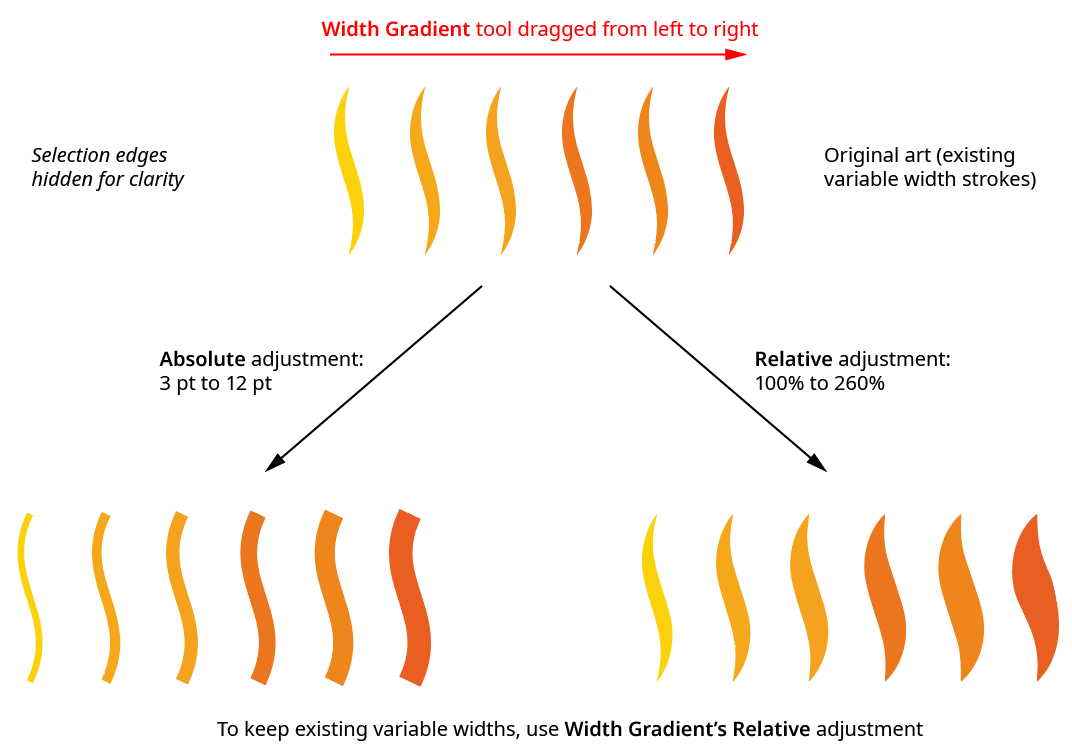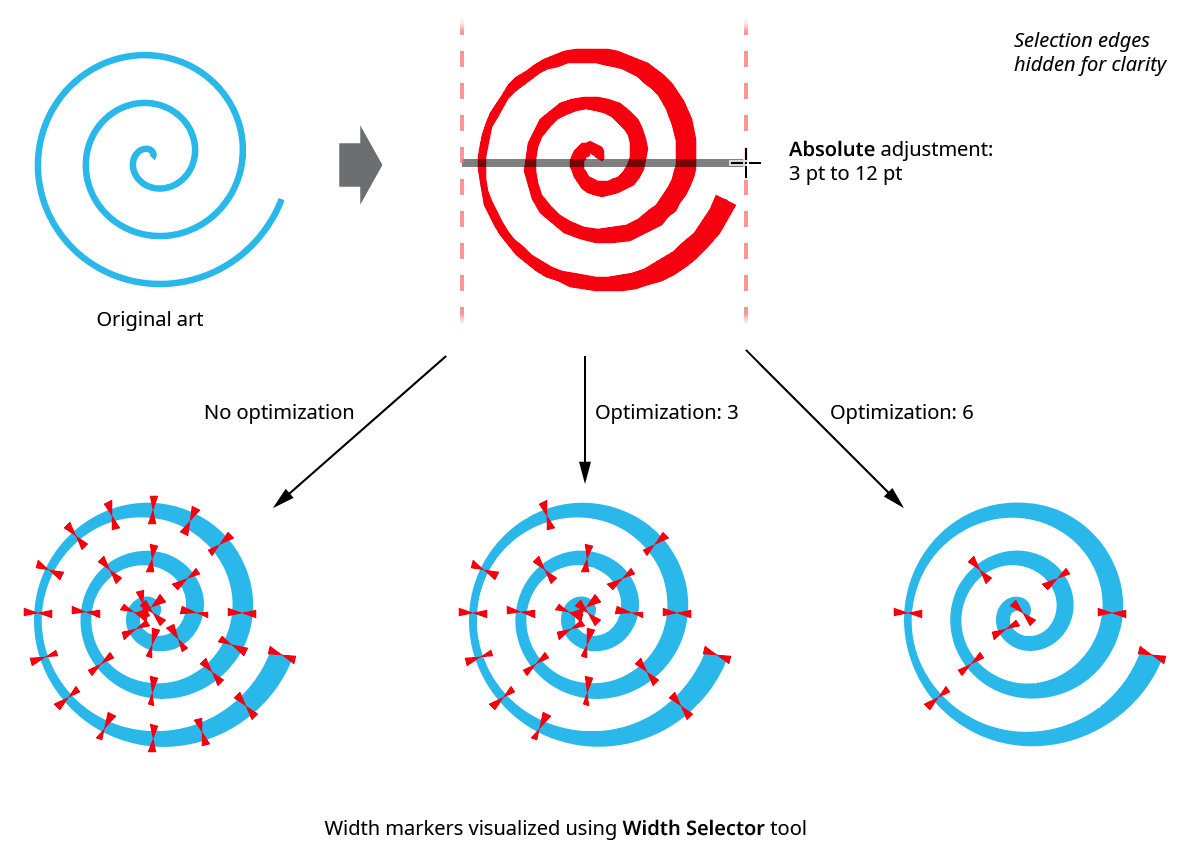 Width Gradient Panel
Width Gradient Panel
The menu item to show and hide the Width Gradient panel can be found in the main menu under Window > Astute Graphics > Width Gradient. When the Width Gradient tool is not in use, the panel displays only a “Click to select” message; clicking anywhere on the panel selects the tool and displays all the controls, which affect the next use of the tool.

Width Gradient Panel
1. Flyout menu
See Width Gradient Panel: Flyout Menu.
2. Panel banner
The Width Gradient panel banner has a help button on the right which opens the help documentation in the Astute Manager. If this does not automatically appear, please ensure your Astute Manager is running first.
3. Linear/Radial Mode
Switches the tool between linear (straight line) and radial (circular) modes. This can be accomplished while dragging the tool by holding down the Option/Alt key.
4. Absolute/Relative Adjustment
Switches the tool’s adjustment type. When set to absolute, width markers are set to the widths calculated based solely on the adjustment values, graph, and position along the virtual gradient; the original width has no influence on the final width. When set to relative, the width at each marker is calculated as a percentage of the original width of the stroke at that position along the path.

Width Gradient Absolute vs. Relative
5. Optimization
When enabled, the number of width markers in the resulting paths will be reduced after the gradient has been applied. The degree of optimization can be set from 0 to 10, with a default of 5. Higher optimization values will remove more width markers, making the path profile smoother and easier to edit manually, but may result in slightly less accurate results compared to the unoptimized results. The number of width markers on a selected path is displayed at the bottom of the panel, if Display Marker Count is enabled in the panel flyout menu.

Width Gradient Optimization
6. Adjustment Value 1
Because it is at the top, this value can be thought of as the “maximum” value, although it can be set to any value. When the graph curve is set to the default (a straight line rising from lower left to upper right), it controls the width at the end of the gradient. It can be changed while dragging the tool by pressing the Left Arrow and Right Arrow keys.
7. Switch button
Switches the two adjustment values; this can also be achieved while dragging the tool by pressing the W key.
8. Adjustment Value 2
Because it is at the bottom, this value can be thought of as the “minimum” value, although it can be set to any value. When the graph curve is set to the default (a straight line rising from lower left to upper right), it controls the width at the start of the gradient. It can be changed while dragging the tool by pressing the Up Arrow and Down Arrow keys.
9. Graph
Specifies the relationship between the adjustment values and the gradient. The horizontal axis represents positions along the gradient (from beginning to end), while the vertical axis represents the adjustment amount, specified by the “maximum” and “minimum” value inputs. With the default diagonal line, the relationship is a linear one. Nodes on the curve may be moved simply by clicking and dragging them. A new node may be added by clicking at a spot along the curve which does not already have a node. Nodes (except the ones at the beginning and the end of the curve) may be deleted by dragging them off the graph area.

Width Gradient Graph Examples
10. Graph Preset Menu
Provides access to saving, managing, and applying graph settings.

Width Gradient Graph Preset Menu
A. Save Graph…
When you save the current graph, its nodes and maximum and minimum values are captured to an internal file which can be recalled later. The file name may be specified.
B. Manage Graphs…
Brings up the Manage Graphs dialog, which lets you rename, delete, import, or export graph files:

Width Gradient Manage Graphs Dialog
a. Rename: Allows the selected graph file to be renamed.
b. Delete: Removes the selected graph file(s).
c. Import...: Imports a previously-exported graphs package file of type “.wgg” using the standard operating system open file dialog.
d. Export...: Exports the selected graph(s) into a graphs package file of type “.wgg” using the standard operating system save file dialog. This file could be used as a backup or passed to another user.
C. Graphs List
Choosing a graph file from this list will update the graph to the values saved within that file (or, the case of “[Default]”, to the default graph). If the Shift key is held down when choosing a graph file, then the current maximum and minimum adjustment values will be retained rather than being loaded from the graph file. When the plugin is first installed, five presets will be added; their names are indicative of the shapes of the curves (for example, curve named “V” goes down and back up).
11. Reapply Gradient button
Reapplies the gradient at its previous position but possibly with new optimization, adjustment width, and graph settings. This allows you to try different parameters without having to actually drag out the gradient in the exact same spot repeatedly. Note: The reapplied gradient will always keep its original mode, i.e. linear or radial. For Relative Adjustment gradients, the path’s width markers will be restored to their original values before the gradient is reapplied unless Option/Alt is held down when clicking the button; in that case the gradient will modify the already-adjusted widths. If the adjustment were set from 102% to 102%, say, this could be useful for incrementally increasing all the stroke weights of the selected paths until they “look right.”
12. Marker Count
Displays the number of width markers (if any) on the selected paths. To visualize these width markers, use the Width Selector tool (also part of the WidthScribe plugin).
Width Gradient Panel Flyout

Width Gradient Panel Flyout Menu
1. Hide Curve
The middle section of the panel (containing the adjustment value input boxes, Switch button, graph, and Reapply Gradient button) can be shown or hidden using this menu item to save space. When the controls are hidden, the menu item will change to Show Curve.
2. Show Preview
When marked with a check mark (the default), paths will be annotated to show an approximation of their final widths when using the Width Gradient tool.
3. Display Marker Count
When marked with a check mark (the default), the informational line showing width marker counts will be shown at the bottom of the panel.
5. Reset Warning Dialogs
If one or more of Width Gradient’s warning dialogs have been suppressed using the Don’t show again checkbox, choosing this menu item will re-enable them.
